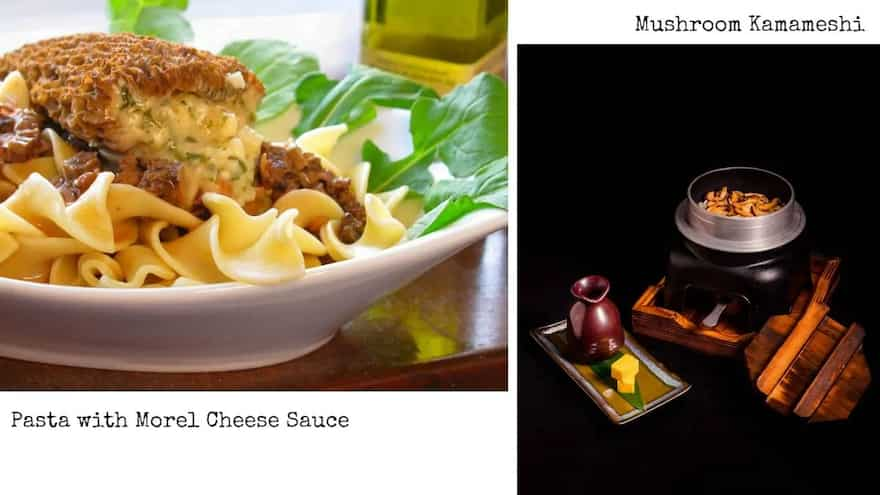Overnight, very / Whitely, discreetly, / Very quietly / Our toes, our noses / Take hold on the loam, / Acquire the air. / Nobody sees us, / Stops us, betrays us; / The small grains make room.
From inspiring Sylvia Plath’s extended metaphor on the women’s rights movement to being named “Ingredient of the Year” by the New York Times for 2022, and topping food forecast trends for the past four years before that — mushrooms are having an extended moment in the spotlight.
They’ve been part of human diet since the time we were hunter-gatherers, but their current rise owes much to the growing popularity of the plant-based food movement. With their meaty texture and taste, and nutritional value, those shifting to vegan or vegetarian lifestyles have upped their consumption of mushrooms. And in the food sector, the range of uses to which mushroom is being put has spurred the uptick.
Mushrooms are sustainable — requiring minimal water, space and electricity to grow. Biodegradable packaging, plus the use of mushrooms to brew alcohol-free craft beer and to create dairy alternatives are further enhancing the attractiveness of mushrooms to conscious consumers.

In India, mushrooms have been a mainstay of both vegetarian and non-vegetarian lifestyles. But here too, chefs have introduced new varieties of mushrooms that diners may not have been used to, and innovated with recipes that marry the best of the mushroom’s attributes with Indian flavours and cooking.
“Edible mushrooms have dominated the F&B sector and it is a multibillion-dollar industry today owing to their low-cost production in comparison to meat products,” Navneet Shekhawaat, head chef of Nest Jaipur Resort, tells Slurrp. “The rise of conscious consumerism has also contributed to the popularity of mushrooms worldwide. The young generation is quite concerned for the environment and ecology, and they are aware that mushrooms are a sustainable food with the unique property of absorbing carbon and [have] no methanol emission.”
Shekhawaat offers a mushroom spin on four dishes at Nest Jaipur: Shiitake and Chicken Congee; Spicy Mushroom Larb; Grilled Mushroom Antipasto Salad; and Yakhni Mushroom.
Soft fists insist on / Heaving the needles, / The leafy bedding, / Even the paving. / Our hammers, our rams, / Earless and eyeless, / Perfectly voiceless, / Widen the crannies, / Shoulder through holes. We / Diet on water, / On crumbs of shadow, / Bland-mannered, asking / Little or nothing.
There are approximately 2,000 types of mushrooms that have been identified as edible worldwide. India has about 200 of these 2,000 species. Some varieties that are very well-known and cultivated commercially in India are White Button, Portobello, Shiitake, Oyster, Enoki, Shimeji, Porcini and Paddy Straw. And, as executive sous chef Ramit Kohli of the Taj City Centre, Gurugram, notes: no matter where a specific variety is grown, mushrooms can easily be transported in their dried form, and preserved for years. Kohli uses flavourful Italian Porcini mushrooms — dried — in a Cream of Porcini soup as well as a Porcini Stuffed Steak. That diners are all too aware of mushroom’s health benefits as a superfood makes these dishes menu-stars.
Kohli enumerates other dishes in which mushrooms play protagonist: “In Indian cuisine, we use mushrooms with different lamb main-course preparations, or for making fragrant Kumbh Pulao or even Bharvan Gucchi Curry (stuffed morel mushrooms).”

At the Radisson Blu MBD Noida, mushrooms are a vital component of nearly every course but dessert. Think soups, salads, pulao, bruschetta, curries, kebabs. “Our Gucchi Pulao is one of our richest dishes at Made in India and it’s a bestseller,” says Nitish Kumar Singh, the chain’s executive chef.
“Mushrooms are being used in different ways across the world. For example, we use a mélange of wild mushrooms and truffles in our Al-Funghi pizza, one of the most ordered dishes at Three Kitchens Restaurant & Bar, our all-day dining restaurant. We also have an exclusive station at one of the live kitchens in the restaurant for stir-fried mushrooms where we serve 7-8 varieties of mushrooms during every meal period,” says Mayyur Tiwari, Executive Chef,
At the Ritz-Carlton, Pune, a dedicated station at one of the live kitchens dishes up 7-8 varieties of stir fried mushrooms at every meal service. (In all, the hotel uses approximately 12-13 varieties of mushrooms across their dining experiences.) At Ukiyo, their modern Japanese restaurant, Mushroom Kamameshi (which uses a mélange of fresh mushrooms), and Teriyaki Mushroom Taco (a combination of Shimeji, Enoki, Nori and Soy Garlic Forest) are diner favourites.
Chefs are hopeful that mushrooms will have a flourishing future in India. “As people gain evermore exposure to the world and how mushrooms are used across different cuisines, they’re keen to sample various types of mushrooms and experience their unique tastes and textures,” says Dr Vikram Vithal Kamat, chairman, VITS Kamat Group. In other words, as Sylvia Plath underlined —
So many of us! / So many of us! / We are shelves, we are / Tables, we are meek, / We are edible, / Nudgers and shovers / In spite of ourselves. / Our kind multiplies: / We shall by morning / Inherit the earth. / Our foot’s in the door.


